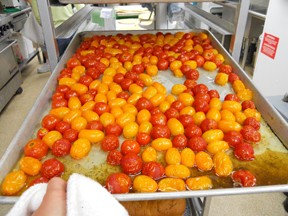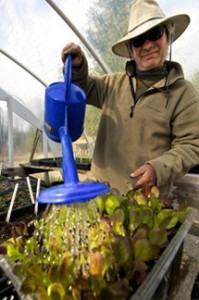Beyond Cherries and Whitefish
- Share
- Tweet
- Pin
- Share

In the last couple of years, the local food movement in Door County has made vast strides. Each town has their own farmer’s market, produce stands abound, and now there are several locations in the county to buy local, organic meat. More and more restaurants feature menu options made with local ingredients. Where in the past, our shtick has largely been about apples, cherries and fish boils, we are moving toward a future where locals, tourists and business owners recognize that we are capable of so much more.
“Door County’s a very unique place in the state and the Midwest. But even as a vacation destination, we have to keep reinventing ourselves into a place that people still want to visit,” Door County Economic Development Corporation Executive Director Bill Chaudoir said.
Chaudoir added that by pioneering the Buy Local movement in northern Wisconsin, Door County has the opportunity to show other rural communities how to get food from the farms that surround us to the locals’ kitchens.
“Our geography doesn’t make it easy,” Chaudoir said. “That, being what it is, also makes us an interesting and beautiful place. We are on our way. We’re making these baby steps and the more passionate people who get involved the better.”

The Cookery Restaurant & Wine Bar in Fish Creek makes a concerted effort to use local produce, including cherry tomatoes that they stock up on when they are ripe, roast, freeze and use throughout the year on a caprese flatbread.
Carol Skare, owner of The Cookery and member of the Door County Buy Local Steering Committee, is one of those passionate people.
“I grew up on a farm,” Skare said. “This is something that goes back to my childhood. It wasn’t hard for me to start working with the farmers. It seemed like a natural progression to add local meats, eggs and produce to our menu. Our customer’s notice the difference in the taste and quality of our food, and our staff is excited about it.”
One of the biggest obstacles the steering committee faces is simply education – spreading the word so that more residents and visitors buy and consume whatever local food they can. Some people feel disinclined to purchase local produce that they don’t know how to prepare. Teaching them how to cook something like kale or Swiss chard could increase consumption of these nutrient rich, high fiber gems.
That brings us to the logical next step in the consumption of local food in the county: a cooperative grocery store. Many people believe that our community could benefit greatly from a co-op. From construction to management and staffing, a Door County co-op would create jobs and bring people in the community together.
Skare suggested that a co-op would also be a great place for a kitchen incubator, similar to the one in Algoma, where people could learn how to cook difficult vegetables. They could take classes in canning and pickling – and then have a space to do it on their own.
“Having a co-op located in the north and south of Door County would provide growers with one drop-off point instead of a lot of backdoors,” Skare said. “Then restaurant owners and consumers wouldn’t have to go to a lot of different places to buy local.”
Skare added, “I don’t think it would affect our farmer’s markets, either. A co-op would provide a place for overflow produce – when there’s a surplus of something, like tomatoes. You don’t want the farmers to have waste at certain times of year when things are abundant.”

Tom Horsley, of Horsley Gardens and Appleport Organics, waters some of the early season greens he grows in his greenhouse. Horsley, who has been gardening since the 1980s, sells his produce at farmers’ markets, as well as supplies local restaurants, including Base Camp and Wild Tomato. Photo by Len Villano.
Tom Horsley of Horsley Gardens in Sister Bay also sees the benefits of creating a growers’ co-op.
“A grower’s co-op means that the growers get together, pool their products, and set a price that reflects what their costs are,” Horsley said. “Then, the growers work together on the marketing and selling of it rather than competing with each other. It’s tricky in Door County because everyone’s sort of doing their own thing, but I don’t think the challenges are insurmountable.”
Horsley has been gardening since the 1980s when he began gardening in Sonoma, California. Walking around his Door County garden, even in late March, garlic and shallots were already sprouting, as well as artichoke plants – his latest experiment.
Horsley participates in the Sister Bay Farmer’s Market every year, with varying levels of success. The location of the market is not conducive to people wandering by, and Horsley finds that people sometimes have difficulty finding him from one year to the next.
“All the farmers have to drive to one central place for the market, so why don’t we drive to a place where the people can walk to us? The obvious location would be in the middle of Sister Bay, and not out on the highway,” Horsley said.
The market also functions as a social networking scene, and a more centralized location would mean more people stumbling upon the market, getting a chance to talk to growers. Horsley said that he often makes connections with people who later come out to his garden to pick something up for a dinner party, or a specialty ingredient for a recipe.
Working with restaurants, Horsley said, can be really rewarding, but also really challenging. He’s currently providing local produce to Base Camp in Sister Bay and to Wild Tomato in Fish Creek.
Horsley said, “I’ve talked to a few restaurants in the past where they were really excited about putting local food on the menu. Then when I showed up, they didn’t know what they wanted or if they wanted it…and that doesn’t work. I got to pick it, bring it here, and you have to take it.”
During my conversation with Horsley, he suggested one obvious step: that our grocery stores should have a local produce display. Often, he said, the grocery stores are not even selling local apples. If they had such a display, it would provide an avenue for farmers to make sure surplus food didn’t go to waste, and it would be easy for the consumer to support our local economy.
At Main Street Market in Egg Harbor, co-owner Kaaren Northrop has been incorporating local products and produce for years, but she says there are consumer expectations that make relying on local produce a challenge.
“The people who only have 12 pints of strawberries – they can sell those at a farmer’s market,” said Northrop. “I need hundreds of pints, not 12.”
Main Street works with Cherrydale Farms in Jacksonport for year-round produce and Schartner’s Farm Market for in-season produce.
“We need product,” she said. “We can’t have people coming in looking for tomatoes, and we don’t have any because our supplier didn’t provide them…We can’t be out of something.”
It takes a lot of coordination between the store’s produce manager and the grower about what, when, and how much produce is going to be available.
“Kyle Bley, our produce manager, and Dave Schartner have a great working relationship,” said Northrop. “Dave can tell Kyle almost exactly how much he’ll have, and when, and then we can buy from our other sources accordingly.”
“It’s more work – way more work,” continued Northrop. “So you, as a business owner, have to make a choice. We made the decision we aren’t going to be a cookie-cutter grocery store.”
The creation of a four-seasons farm market in Sturgeon Bay marks another effort in the Buy Local movement. As part of the West Waterfront Area Redevelopment Plan, Chaudoir and his colleagues are trying to organize a market that would be constructed in the area next door to the Door County Maritime Museum.
Chaudoir said, “We envision a very attractive building, oriented toward the water, with indoor and outdoor sales facilities. It would have rented space available to local businesses, a brewpub, and be an outlet for all the food products we have in Door County. We’re hoping to make it a regional food trailhead – a one-stop-shopping location for local products.”
For the Buy Local movement to gain more momentum, Door County’s residents have to start making a conscious effort to buy local. Already, people are becoming increasingly conscientious about what they eat. Growers and buyers need to start thinking communally when it comes to food.

(Left to right) Karin, Courtney and Carol Skare taste their cherry pie filling, sourced from locally-grown cherries, canned on site, and sold alongside their other pie fillings, jams, sauces and relishes at The Cookery.
“Local food has been around forever. It just kind of got lost. Now it’s being rediscovered,” Horsley said.
The more our businesses advertise local food, the more our residents and visitors will ask for it, and the more our farmers will be able to grow.
Chaudoir said, “There are many opportunities for the Buy Local movement to perpetuate and really grow. But it’s not going to happen overnight. It’s a journey.”


